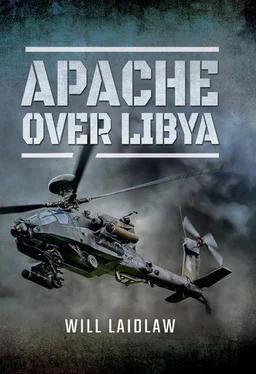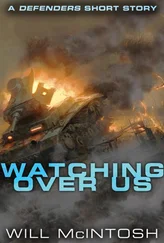Actual time over Libya was known as ‘Vulnerable time’ for all aircraft, shortened to ‘Vul’. Within the Vul there were distinct periods when the risk of being shot down increased. Crossing the coast and at the target area were always regarded as the riskiest points on any mission. This was when the jets would be ready to assist; quite how was never clearly explained, but they had to be up above when we were down there. Concern over the Apache Vul window led to long discussions over risk and how to deal with it. As a matter of course, jets that could detect, jam or shoot radar systems were on hand. Without them it was a ‘No Go’. Later, fast jets such as F-16s and Tornados were added, as well as drones with eyes on the target to hand over to us. All of this lowered our risk and meant it was a ‘Go’. As the operation went on, I decided to refine Apache risk management down to the nine things that could kill us over Libya. These included SA-24, PKM man- and radar-guided missiles, as well as the physical environment and hazards such as pylons and wires. I would consider whether we might encounter the threat, then demonstrate what we could do about it both in planning and in action. It was not scientific and relied completely on military judgement. The only thing on the list that a jet could assist with was the radar-launched and -guided missile, but only after a missile was on its way at the first Apache.
When it came to the other threats out there, jets stacked 5 miles up above us were just going to watch the crash site and tell the CAOC what they could see. This didn’t make us safer, it just made planning more complicated. Insistence on the use of a drone was reasonable for missions where the CAOC wanted to see the targets before we engaged. This gave them control, a long lens, the ability to make a decision. Precision targeting was vital and they needed to iron out every possibility of a mistake. It also allowed us to hold off until the target was good to go. This made it safer for us, but being paired with the Pred became an anchor. ‘No Pred, No Go’ saw several missions scrapped later in the operation.
A deluge of information arrived from the CAOC. All of it in jet lingo and all of it in need of translation. There were new maps and satellite imagery to be examined, radio frequencies to be programmed and airspace coordination to be understood and transposed into our planning systems. Everything was done from first principles as though we were the first people to do this job – which we were. This is the first and most lasting lesson of contingent operations. There is no handover, no one there to tell you what to expect. You don’t get a familiarization trip or a well thumbed map and list of contacts. Safe places and hostile places are not yet known. Everything is new and it is up to you to find the best way to stay alive and the right way to win.
I read through the communications document. It was a thick forty-pager written by wiggly amp experts, who clearly understood numbers and radios but not much about delivering simple information in an easily understood format. This was critical stuff and we had to get it right, but I had no chance of understanding it. John Blackwell was our radios man so I had a quiet chat with him.
‘You understand the radios don’t you, Staff?’ I casually asked, handing him the NATO communications list and procedures.
‘Yes. First there are the V-UHFs, two of them…’ He launched into his I’ve-just-done-a-Standards-check-and-I-know-everything lecture.
I interrupted: ‘You could give me wiggly amps and algorithms and cypher and blah, blah, blah, but there are not enough years left in our careers for me to take it all in. You see, Staff, inside those radios are millions of tiny men. Some days they work well together and the radios work. On other days they don’t work well and radios don’t work either.’
‘Er… yes, okay.’
‘Just take all this NATO comms voodoo and make it into a picture that I can understand in the dark, low-level, no light, getting shot at.’
He took the document from me. ‘Don’t worry, I won’t tell Big Shippers about the massive gap in your understanding of the aircraft!’
In the last 24 hours before the mission we had everything in place. Ocean lay over a hundred miles from Libya, able to head either west or south to launch a mission, keeping Gaddafi guessing. In the flip-flop the Ops team of six soldiers had been working 12-hour watches to ensure all the NATO data had been entered into the mission planning systems. Every detail from the daily changing Airspace Control Order had to be plotted. This happened while the aircrew were in rest, and by the time we had received our orders and targets for a mission, there was minimal input required. Soldiers with an average age of just twenty-four were trusted to programme mission-critical information with the minimum of supervision. This was their job and they were good at it. We knew they could be trusted to get it right first time. An incorrect keystroke could misplot a hazard, a mast, a front line; or a frequency could be wrong and we would be alone in the dark in a fight with no one to hear us. Trust generated belief and created one coherent planning team.
So the plan was made, checked and rechecked. The threat was discussed and our ‘actions-on’ rehearsed. We ran through every conceivable variation of threat and our response, including what to do if we had to make a forced landing in Libya. We each had hundreds of rounds of ammunition for our A2 Carbines and Sig Saur pistols. We had GPS, radios, locator beacons, night vision and escape maps stuffed into our life vests and grab bags. Extra batteries and a few bottles of water filled any spare room. This equipment, along with our body armour, added an extra 15kg per man. Not a big deal on the move on the ground, but a significant issue if the forced landing was into the sea. Our final concern was who would come and get us if we had to make that forced landing.
Combat helicopter pilots have to consider the chance of being shot down. There is no ejector seat. If the aircraft is unflyable everyone inside accompanies it to the ground, or into the sea. If the aircraft has been taken by the incoming, the aircrew might also have been injured. In the Apache, where the aircrew are in separate tandem cockpits, self-aid replaces first aid. Then, having been unable to conceal a 58ft long, 8-tonne crash landing, the aircrew are now into escape-and-evasion mode. If they are in the sea, then getting to the surface is the aim. Once there, it’s time to inflate the individual life raft and wait. If they are on the ground a running shooting match is the most likely outcome.
If we went into the sea and it was sufficiently far from shore a ship could come and scoop us up. If we went in over land we were on our own. The NATO Combat Search and Rescue (CSAR) was held at five hours notice to move. This meant that from the point of being notified of downed aircrew the CSAR could take up to five hours to launch. We could reasonably assume that during those five hours our landing site would be compromised and daylight would be upon us. We would be running, probably running and shooting, behind enemy lines. We would have to choose where to go – try and make it to a safer rebel-held place or go deeper into pro-Gad territory. Getting to the rebel side meant crossing the front line and meeting ever-increasing numbers of regime soldiers. Time would favour pro-Gad. Bad luck in the incoming meant at least 24 hours on the run in the ‘danger zone’. We had to accept this, and we did, but Wings got on in the background and began to organize a better option. The rescue situation would improve, but not for three weeks.
Our limits and our risks were reasonably well understood. The first mission was to be an ‘easy-on’ – a crawl, no tricky targets, just a straightforward ‘get in, shoot, go feet-dry for a few minutes and leave’. No dramas, not an area of high pro-Gad concentration, but enough to get us into the operation and get a message out in the media. NATO chose the time and the place, and not even the embarked and trusted journalists were told of the mission until an hour before we briefed. Even then, they weren’t told where we were going until the aircraft lifted from the flight deck.
Читать дальше












